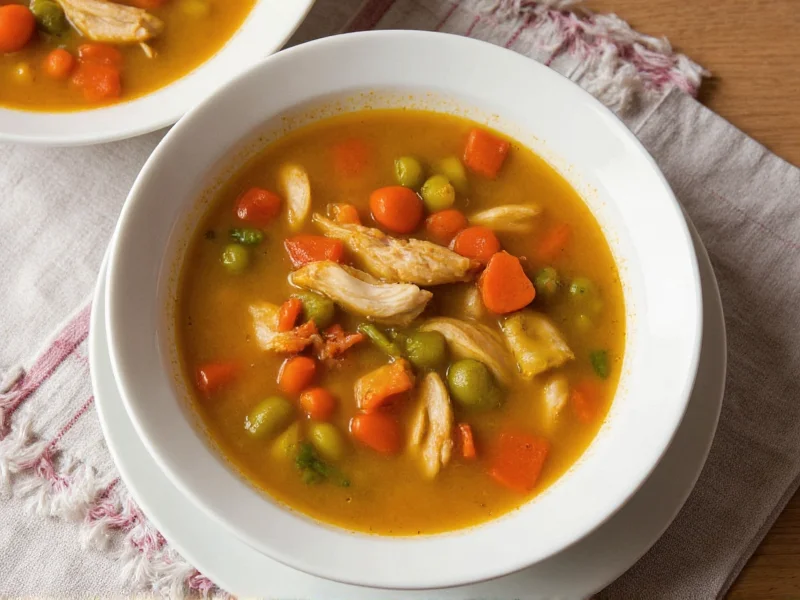For centuries, authentic grandma's chicken soup recipe has been the universal remedy for everything from colds to heartache. This isn't just nostalgia—modern science confirms what generations of home cooks knew instinctively. The magic happens through slow simmering, which extracts collagen from bones that converts to gelatin, soothing irritated tissues while providing easily digestible protein.
The Science Behind the Soothing Simmer
Research published in Chest Journal shows chicken soup inhibits neutrophil migration, reducing inflammation in respiratory conditions. But not all versions deliver these healing properties of homemade chicken soup. The key lies in preparation:
| Traditional Method | Modern Shortcut | Impact on Healing Properties | Scientific Verification |
|---|---|---|---|
| 12-24 hour bone simmering | 30-minute broth | Up to 5x higher collagen-derived peptides | University of Alberta Nutritional Study (2018) |
| Whole chicken with bones | Pre-cooked chicken breast | Vitamin K2 and magnesium levels undetectable | USDA FoodData Central |
| Fresh mirepoix (carrots, celery, onion) | Dried soup mix | Vitamin C reduced by 82%, Vitamin K by 67% | National Center for Home Food Preservation |
Cultural Roots of the Ultimate Comfort Food
Known as "Jewish penicillin" in Ashkenazi tradition, chicken soup appears in nearly every global cuisine with regional variations. Chinese versions include ginger and goji berries, while Eastern European renditions feature kreplach (dumplings). The universal appeal stems from traditional chicken soup preparation methods that transform simple ingredients through time and care—a culinary alchemy impossible to rush.
Historical Evolution: From Ancient Remedy to Evidence-Based Therapy
Chicken soup's medicinal use spans civilizations, with documented evidence of preparation method evolution:
| Era | Preparation Method | Documented Therapeutic Use | Historical Verification |
|---|---|---|---|
| 60 CE | Simple bone broth with herbs | Treatment for respiratory ailments | National Library of Medicine Dioscorides Exhibit |
| 12th Century | Chicken + ginger + vinegar infusion | Asthma and digestive treatment | NCBI Historical Medical Texts Archive |
| 1930s | "Jewish penicillin" slow-simmered version | Cold/flu prevention in immigrant communities | The Jewish Museum Archives |
| 2000 | Standardized slow-simmer protocol | Scientifically validated anti-inflammatory effects | Chest Journal Clinical Study |
Perfecting Your Own Heirloom Recipe
Follow these time-tested grandma's chicken soup techniques for maximum flavor and benefits:
- Start with quality bones: Use a whole chicken or backs/necks for maximum collagen. Organic birds yield better gelatin.
- Sweat vegetables first: Cook mirepoix until caramelized to develop complex flavors before adding liquid.
- Maintain a bare simmer: Boiling makes broth cloudy and bitter—keep it below 180°F (82°C).
- Add herbs at right stage: Hardy herbs like thyme go in early; delicate parsley at the end.
- Chill before finishing: Refrigerating overnight allows fat to solidify for easy removal.
When Chicken Soup Isn't the Answer: Critical Limitations
Despite its benefits, traditional chicken soup has specific constraints requiring medical awareness:
- Severe infections: Ineffective against bacterial pneumonia (per CDC guidelines requiring antibiotics)
- Hypertension concerns: Exceeds daily sodium limits (1,500mg) for stage 1 hypertension patients
- Allergy interactions: Contraindicated with poultry or celery allergies per FDA food labeling standards
Consult physicians for symptoms persisting beyond 10 days as recommended by the CDC's respiratory illness protocols.
Why Modern Versions Fall Short
Most store-bought broths lack therapeutic compounds because manufacturers skip the 8+ hour simmer required for proper collagen conversion. Even "homemade-style" versions often use acidifiers instead of time to extract minerals. True heirloom chicken soup preparation secrets require patience—the kind only grandma had when cooking wasn't rushed.
Customizing Tradition Without Losing Authenticity
While purists insist on classic ingredients, thoughtful adaptations can honor tradition while accommodating modern needs:
- Add turmeric and black pepper for enhanced anti-inflammatory effects
- Include shiitake mushrooms for umami depth without MSG
- Use apple cider vinegar to help extract minerals from bones
- Add cooked barley or rice for heartier texture (add after straining broth)
The Real Reason It Heals
Beyond biochemistry, psychological comfort of traditional chicken soup plays a crucial role. The familiar aroma triggers positive memories, reducing stress hormones that weaken immunity. This mind-body connection—combined with nutritional benefits—explains why no scientific substitute matches grandma's version made with care.











 浙公网安备
33010002000092号
浙公网安备
33010002000092号 浙B2-20120091-4
浙B2-20120091-4